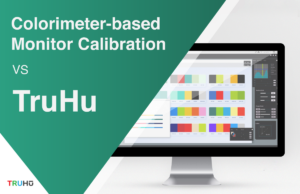Last Updated on February 24, 2025 by Clark Omholt
Browse Frequently Asked Questions by Topic:
I. Using TruHu
1. How long does it take to calibrate my screen with TruHu?
Once the TruHu desktop and mobile apps are installed, it only takes 1-2 minutes to calibrate your screen.
2. How long should my screen be on before calibration?
Some screens have a “warm up” period after being turned on, during which certain characteristics, like brightness and color temperature, are changing. Thus, it is recommended that you calibrate with TruHu after your screen has warmed up. Thankfully, most modern screens stabilize quickly, in about 10 minutes. If your screen is older, say 2017 or earlier, it would be a good idea to let your screen warm up for 20 minutes before calibrating. If you put your screen into “sleep” mode, rather than turn it off, this keeps the backlight at a constant voltage and should allow your screen to stabilize in a few minutes after “waking up”.
Explore this topic in more detail in our dedicated blog entry on how long screens should be on before calibration.
3. How often should I calibrate my screen?
LCD screens are much more stable than their CRT predecessors, so the old recommendation of “calibrate your screen daily” no longer applies under most circumstances. The primary part of your LCD screen that changes over time is the backlight, so recommended calibration frequency is related to total hours the screen was used since the previous calibration. For professionals, who are assumed to have the screen on ~40 hours / week, the recommendation is to calibrate monthly. For more casual users (e.g., internet shoppers), you should be fine calibrating every 3-6 months. Thankfully, TruHu is easy to use and doesn’t take much time, so no problem calibrating more frequently. Your license comes with an unlimited number of calibrations.
4. I have two side-by-side screens on my desk, and after calibrating both with TruHu they don’t exactly match as closely as I hoped. What can I do about that?
This is one of the most challenging situations for calibration tools, since the human eye is so sensitive to subtle differences in a side-by-side setting. We are trying to achieve a metameric match, but the greater the difference between the spectral curve of the two displays’ backlight the more challenging this is. We would expect TruHu to get you into the same ballpark, but for the closest match possible we suggest you use two models of the same display.
5. I’ve finished calibrating my screen with TruHu, and I don’t see much of a difference between the before and after images. What’s that telling me?
Congratulations! That means your screen was in a reasonably good state to start, but that doesn’t mean your TruHu calibration isn’t valuable. TruHu gives you the peace of mind of knowing your screen is in a good state, and your subscription will help maintain that good state over time. Additionally, there may be some images, like those with lots of shadow detail, where your TruHu-calibrated screen will reveal subtleties that weren’t seen previously.
6. I’ve finished calibrating my screen with TruHu, and it appears kind of dim. Is that correct? Will turning up the brightness mess up the calibration?
In order to achieve the specified White Point, TruHu makes changes to the computer’s video card lookup table’s RGB values. They start at 100% (max) and TruHu reduces the max values as needed. For example, to achieve a warmer White Point, TruHu may reduce the max blue value. There is no option to go above 100%, so White Point adjustments inevitably reduce overall luminance. Thankfully, modern displays keep a pretty consistent white point as you adjust brightness. So feel free to turn up your brightness to the desired level post-calibration.
7. What are those strange patterns I see on my phone when I’m photographing my monitor with TruHu, and are they a problem?
These are known as moire patterns and are a result of an interaction between your phone’s high resolution sensor geometry and the geometry of the screen it’s photographing. By showing the gray and color targets at an angle, TruHu minimizes moire problems and thus does not affect the accuracy of the calibration.
8. What if I want different color profiles, like for natural paper prints versus brightened paper prints? Can I do that with TruHu and set them at different color temperatures?
This seems like a common need, and TruHu offers an easy solution. Let’s say you need two monitor profiles, one at 5000K and another at 6500k. By default, TruHu includes the white point in the name of the profile. So it’s just a matter of going to System Preferences / Displays / Display Settings / Color Profile to invoke your preferred profile. Note: If you are on a Macbook Pro 14” or 16”, the interface is slightly different and is described in our blog post about changing Mac display profiles here.
9. Some of my monitors have a blue light filter. How does that affect the situation?
The blue light filter is a coated screen to be placed over your monitor to make your screen appear less blue. As a result, a screen that is natively 6500K might actually measure as a slightly warmer 6000K with the blue screen. That’s no problem. In TruHu just choose a white point that you are comfortable with.
10. I am getting a .NET Desktop Runtime error on Windows, how can I fix it?
TruHu for Windows requires Microsoft’s free .NET Desktop Runtime v6. If your computer doesn’t have this, you will be prompted to download from the Microsoft website. Simply click “Yes” on the error message and it will take you to the download page. Alternatively, you can go to Microsoft’s support article about app launch failures to learn more about Runtime errors and why your app may not be starting.
11. How do I change the frequency of calibration reminders?
To change the frequency of your calibration reminders, simply complete a new calibration (you can keep your existing profile), then select a new reminder frequency when prompted.
II. System Requirements
1. What mobile devices and Operating Systems are supported by TruHu?
TruHu apps (desktop and mobile) are currently compatible with MacOs Mojave and later, and iPhone SE 2nd Gen and later respectively. We are working on Windows and Android versions, set to come out early 2024.
❗️NOTE: TruHu requires a desktop device as well as a mobile device in order to complete a calibration. Make sure both devices meet their respective requirements below:
Computers
– macOS – Mojave / 10.14 and later (as of Sep 2022)
– Windows – Win 7, Win 10 and later (coming in 2024)
Mobile handsets
– Apple – iPhone SE 2nd Gen and later
– Android – Samsung Galaxy Note 7 and later (coming in 2024)
Mobile Operating Systems
– iOS 14.5 and later
– Android 6.0.1 and later (coming in 2024)
2. Can I calibrate my phone or tablet with TruHu?
Currently, TruHu is designed to calibrate only monitors connected to a Mac or Windows-driven computer. iPad/Tablets are not on the immediate planning horizon. But stay tuned… and let us know what you’re looking for in the comments.
3. Does my browser work with my TruHu monitor profile?
For most people, the answer is YES. As of Chrome 94 (released Sep 2021), this browser is harmonized with Safari and Microsoft Edge in making use of your monitor profile and displaying tagged imagery properly. Untagged images are interpreted as sRGB. Firefox may require user intervention to properly interpret untagged images. As of 2022, Chrome, Safari, and Edge collectively have ~90% browser market share.
4. The text on the TruHu Mobile app seems to be getting cut off. What can I do about that?
Some smaller iPhones with the text set to a very high setting can result in text in TruHu mobile getting cut off. This can be addressed by going into Settings / Display & Brightness / Text Size and reducing the text size.
III. Account Management
1. How do I renew my TruHu subscription?
Your TruHu subscription will renew automatically at the end of the 1 year period after you first subscribed. You will be notified via email of the pending renewal, so keep an eye on your inbox.
2. I would like to cancel my account – how do I do that?
To end your TruHu subscription and stop its recurrence, visit your account section on the website:
1. Go to the TruHu homepage (truhu.app or click on the TruHu logo at the top of this page).
2. Make sure you are signed in by clicking the Sign In button (upper right corner)
3. After signing in, click on your account info (upper right corner)
4. Click “Subscription and Card” and then “Cancel Subscription”
3. How do I delete my TruHu account?
The way to delete your TruHu account (free OR paid) is to open the TruHu app on your iPhone device, make sure you are logged into the account you want to delete, then go to the Account Settings (top right corner from the Welcome screen). Once there, you should see the “Delete Account” option, which will take you to a confirmation page – tap on the red “Delete Account” button again to finalize.
IV. Color Management
1. What’s the best Color Temperature setting for my screen?
The Color Temperature of white on your screen, also known as White Point, is one the settings you can pick in TruHu. This is really a matter of personal preference. The higher the color temperature, the bluer the white point. The most commonly used Color Temperature for screen calibration is 6500K. The sRGB (common for web imagery), AdobeRGB ( common with Pro Photographers), and DCI-P3 (Cinema) color spaces all use 6500K as the Color Temperature for their White Point, making it a good choice under most circumstances. A white point of 5000K is commonly specified for commercial print applications in North America. This can result in a closer match between screen and paper white under recommended lighting.
2. How do I disable some of the “auto-adjust” features on my Windows or Mac computer, such as Nightlight (Windows) and Night Shift or TrueTone (Mac)?
See our Adjusting Brightness Settings blog post
3. I’m viewing my prints by reflected light at 5000 degrees. So how can you explain to me why I would want my monitor calibrated to 6000?
Assuming your 5000K light box is accurate, my experience has shown that papers viewed in a 5000K light box often match best when the display is calibrated to 5000K or 6000K.
The main reason for this is that many paper manufacturers add optical brightening agents (OBAs) to make their paper appear brighter or whiter. In fact, a spectrophotometer sees an OBA-brightened paper as blue, though the eye sees it as white. Thus, a bluer white point on screen will often produce a better match for OBA-brightened papers.
4. Where can I find my color profiles on my Mac / Windows computer (monitor or printer)?
Mac
➡️ User Level – Finder / Go Menu* / Library (you will need to hold down the Option key to expose “Libary”). Library / Colorsync / Profiles. This is the location where most color-related software places profiles.
➡️ System Level – Finder / Go Menu / Computer / Library / Colorsync / Profiles
➡️ Adobe-installed profiles – Computer / Library / Application Support / Color / Profiles
➡️ Epson driver installed profiles – Computer / Library / Printers / Epson / InkjetPrinter 2 / ICC Profiles. Then R-Click and show package contents. Inside Contents / Resources you will find all the Epson-provided profiles associated with your printer.
*Find the Go menu in the taskbar after opening the Finder window.
Windows
➡️ C: / Windows / System32 / spool / drivers / color
(if necessary, replace C with the drive that matches your Windows installation location)
5. After a full HDR optimization of my Windows monitor and GPU settings, followed by a TruHu calibration, my desktop colors look amazing but my in-game colors look blown out. Why is this happening?
The likely culprit is Microsoft’s “Auto HDR” feature. While this feature is great for unoptimized profiles and monitors, it tends to overcompensate when you set up your monitor and color profile perfectly. As a result, whites look blown out and blacks look crushed.
We recommend turning “Auto HDR” off for TruHu-calibrated monitors by going to Settings > System > Display > HDR Settings > Auto HDR. For more details on getting a perfect color setup for gaming with TruHu, see our article on gaming monitor settings.



this is a comment on the FAQ page.